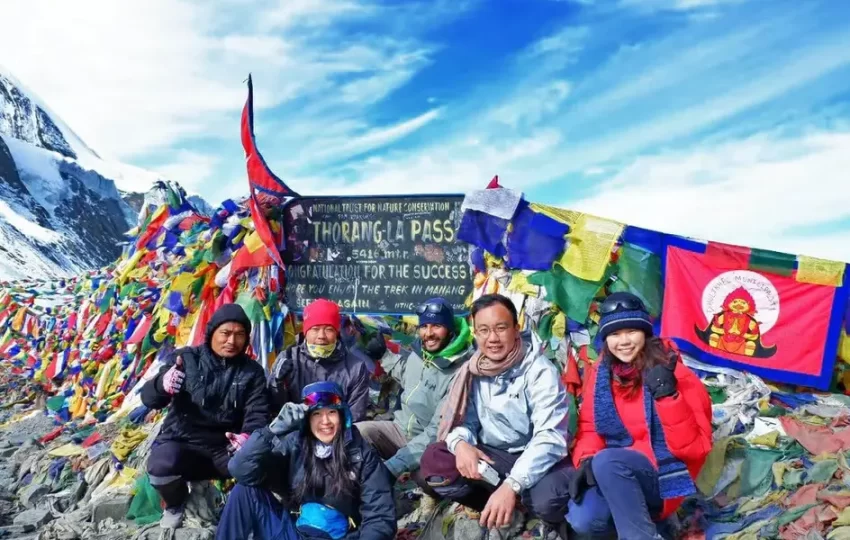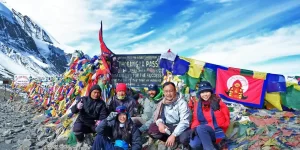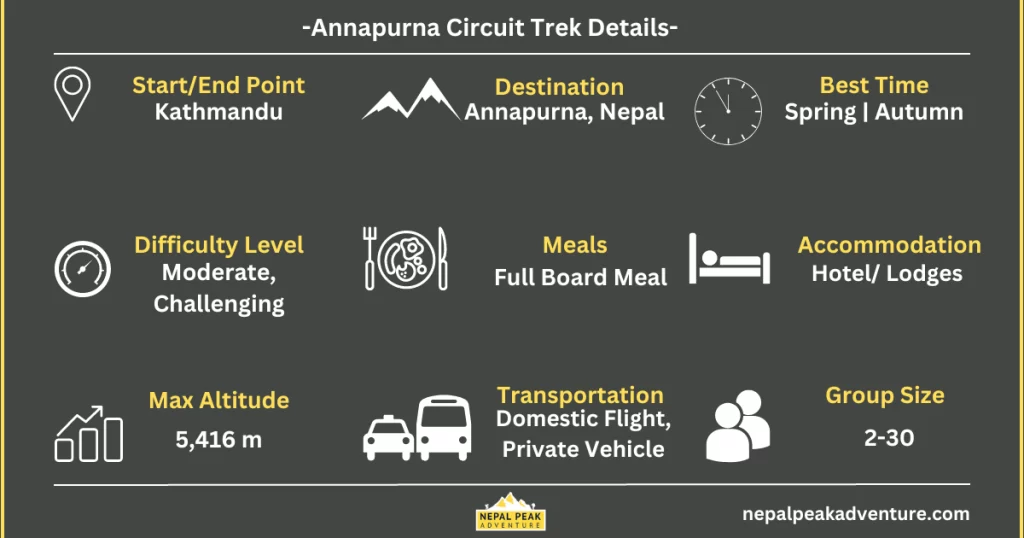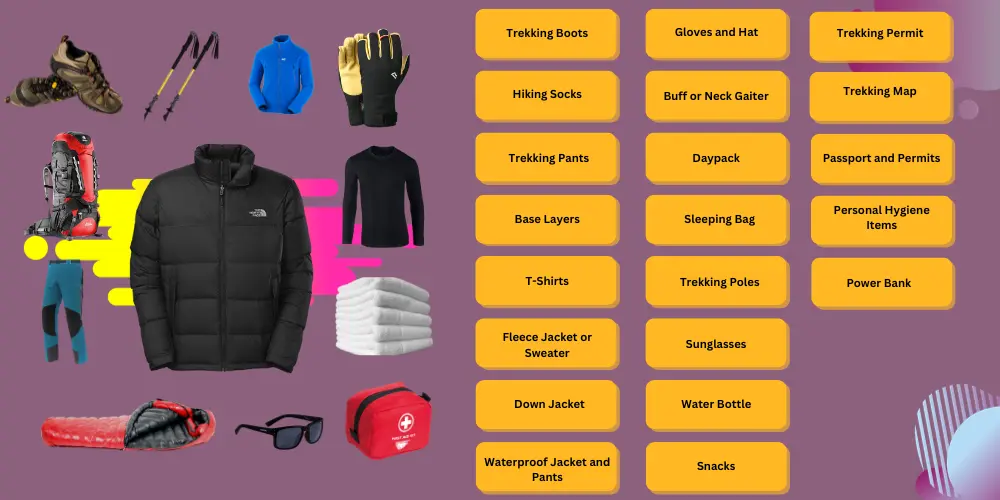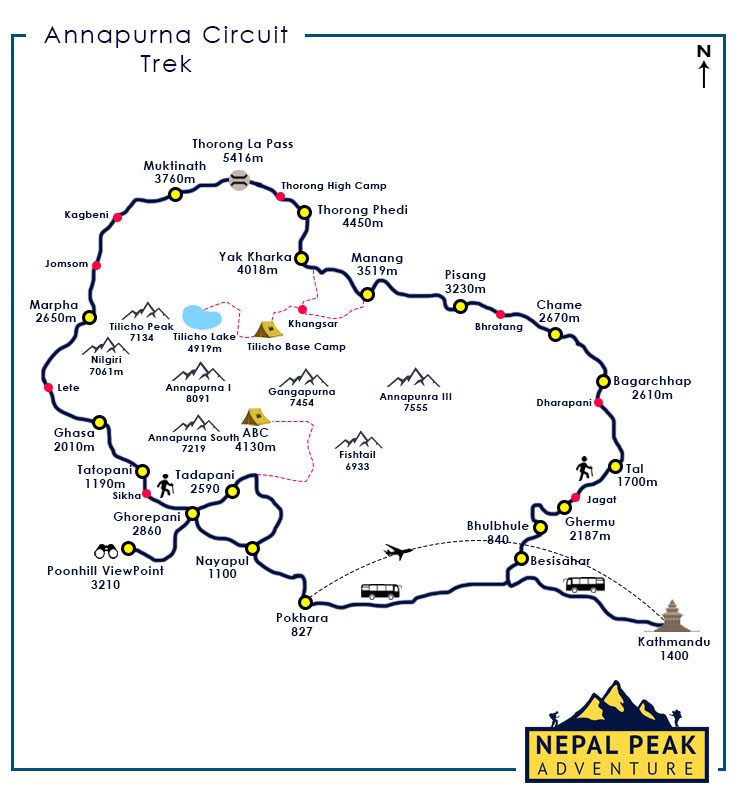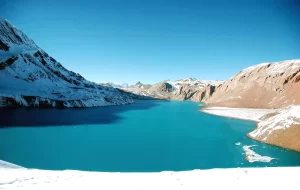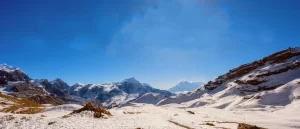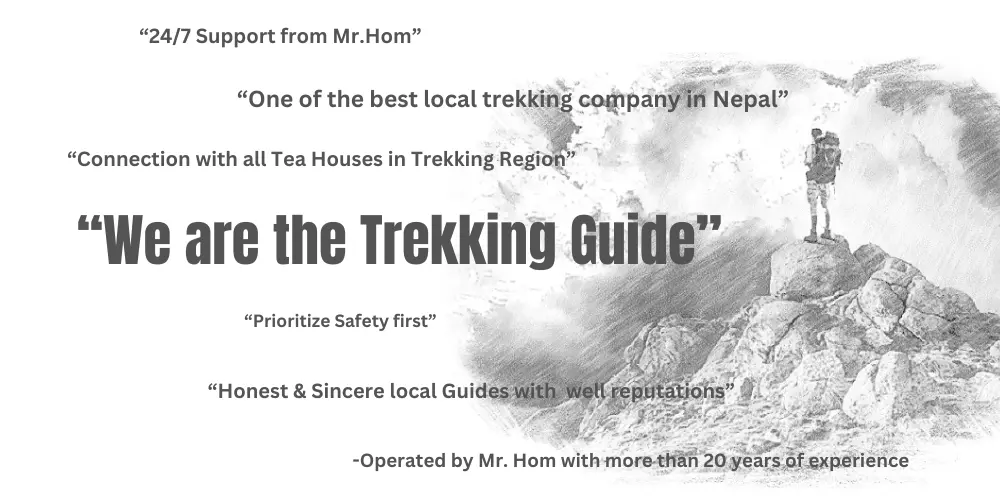The Annapurna Circuit Trek is a breathtaking journey through the diverse landscapes of the Annapurna region in Nepal. Starting from Besisahar, the trek follows the Trishuli and Marsyangdi Rivers, offering stunning views as you ascend towards higher altitudes.
The trek unfolds over 18 days, providing a mix of challenging ascents and rewarding cultural experiences. After passing through picturesque villages like Pisang, Humde, and Braga, trekkers reach Manang for acclimatization on the 8th day. This strategic pause allows hikers to adjust to the increasing altitude.
Day 12 presents a steep ascent to the high camp, culminating in the awe-inspiring Thorong La Pass at an altitude of 54,16m (17769.03 ft). The fluttering prayer flags add a spiritual touch to the cold mountain breeze, marking a significant milestone in the trek.
Descending from Thorong La Pass, the journey leads to Muktinath, a sacred site for both Hindus and Buddhists. The 15th day showcases a scenic walk along a stony path towards the magnificent Rupse waterfall. The trail continues along river banks, through lush vegetation and terraced fields, ultimately arriving at Tatopani—a valley renowned for its hot water springs.
On the 17th day, trekkers hike to the renowned Poon Hill, a popular viewpoint offering spectacular sunrise views over the mountains. The trek then descends to Ghorepani for breakfast before continuing to Tadapani for an overnight stay.
Day 18 takes trekkers to Ghandruk, featuring a downhill trek that concludes at Nayapul. The adventure concludes with a charming one-hour drive to Pokhara, providing a fitting end to the Annapurna Circuit Trek.
Throughout the journey, trekkers are treated to a diverse range of landscapes, from river valleys and waterfalls to high mountain passes. The trek also offers cultural immersion, with visits to traditional villages and sacred sites. The Annapurna Circuit Trek is a holistic experience that combines physical challenge with natural beauty and cultural exploration, making it a memorable adventure for trekking enthusiasts.
More About Annapurna Circuit Trek Package:
Cost Inclusion and Exclusion in Annapurna Circuit Trek:
Here are the services included in the Annapurna Circuit Trek Package:
- Airport pick-up and Drop service in a private vehicle
- Welcome dinner in a Reputed Nepalese Cultural Restaurant
- Twin-sharing accommodation in Kathmandu (2 nights) and Pokhara (1 night) at a tourist standard hotel along with breakfast
- Tourist coach drives to and from Pokhara (air ticket or private vehicle can be arranged on the client’s behalf upon request)
- Accommodation during the trekking in a teahouse/Lodge
- All three meals on the trek (breakfast, lunch, dinner)
- Seasonal fruits after dinner
- Tea/coffee (3 times a day) during the trek
- Government certified English speaking trekking guide
- The entire cost of the staff members involved in the trek (their salary, insurance, equipment, food, and accommodation)
- Porters (one porter for every two trekkers) and his entire expenses (salary, food, accommodation equipment, and insurance)
- Charges of all necessary documentation
- All Permits (Annapurna Conservation Area perm, Trekkers Information Management Systems (TIMS) Card )
- Down jackets and sleeping bags (upon request), should be returned to the company after completion of the trek.
- Company’s duffel bag, and a company t-shirt as a souvenir.
- Trekking route map
- First Aid Kit (carried by a trekking guide)
- Unlimited Hydration Tablet
- The arrangement of helicopter rescue service (trekker’s travel insurance must cover this expense)
- Farewell Dinner at a reputed restaurant
- All applicable federal and local taxes
- Final Departure Transfer
Cost Exclusion:
Here are the services not included in the package:
- Nepal visa and International flight fare.
- Dinner and Lunch in Kathmandu and Pokhara besides welcome and farewell dinner.
- Expenses for your clothing and personal gear
- Your equipment and other expenses such as mineral water, soft beverages, laundry, hot drinking water on the trek, bar bills, showers, internet, battery chargers, etc.
- Your travel insurance which covers helicopter evacuation as well as medical expenses and trip cancellation
- Tipping to the guide, porter, and drivers
- Any other expenses not itemized in the "What is Included in the Trip cost? " are your expenses.
Packing List for Annapurna Circuit Trek:
The Annapurna Circuit Trek requires careful packing to ensure comfort and safety during the diverse conditions along the trail. The average weight that trekkers carry with them is 9kg (19 pounds) while the porter carries 20 kg (44 pounds). Thus, to pack efficiently, here's a concise overview of essential items to include in your packing list:Clothing:
- Trekking Boots: Sturdy, well-broken-in boots with good ankle support. (Can be Rented in Thamel)
- Hiking Socks: Moisture-wicking and comfortable socks for long walks.
- Trekking Pants: Lightweight, quick-drying pants with zip-off legs for versatility.
- Base Layers: Moisture-wicking thermal tops and bottoms for warmth.
- T-Shirts: Breathable, quick-drying shirts for trekking.
- Fleece Jacket or Sweater: Insulating layer for warmth.
- Down Jacket: Lightweight and compressible for extra warmth at higher altitudes. (Can be Rented in Thamel)
- Waterproof Jacket and Pants: Windproof and waterproof for protection against rain and snow.
- Gloves and Hat: Warm gloves and a hat to protect against cold temperatures.
- Buff or Neck Gaiter: Versatile for protecting your neck and face from wind and sun.
Accessories:
- Daypack: Comfortable daypack for carrying essentials during daily treks.
- Sleeping Bag: Warm and suitable for low temperatures at higher altitudes. (Can be Rented)
- Trekking Poles: Adjustable trekking poles for stability and support. (Can be Rented)
- Sunglasses: UV-protective sunglasses for high-altitude sun exposure.
- Headlamp/Flashlight: With extra batteries for evening and early morning use.
- Water Bottle: Insulated and reusable to stay hydrated on the trail.
- Snacks: Energy bars, trail mix, or your preferred trekking snacks.
- Camera: Capture the stunning landscapes along the trek.
- Power Bank: Keep electronic devices charged during the trek.
Toiletries:
- Toothbrush and Toothpaste
- Biodegradable Soap
- Quick-Dry Towel
- Sunscreen: High SPF for protection against intense mountain sun.
- Lip Balm with Sunscreen
- Wet Wipes/Hand Sanitizer
- Personal Hygiene Items
Miscellaneous:
- Passport and Permits
- Cash: Small denominations for tea houses and tips.
- Trekking Map and Guidebook
- Multi-tool or Knife
- Dry Bags or Zip-Lock Bags: To protect electronics and documents from rain.
- Trekking Permit: NPA will manage the permits before starting the trek.
Annapurna Circuit Trek Itinerary and Map
Outline Itinerary
As you can see, after excluding the non-trekking days, it only takes 15 Days to complete the Annapurna Circuit trail. The famous places from the itinerary are Manang, Muktinath, Thorong-La Pass, Jomsom, Tatopani, Poonhill, and Pokhara. Here is an outline of Annapurna Circuit Trek Itinerary:
- Day 01: Arrival in Kathmandu (1400m)
- Day 02: Drive to Besisahar in a commuter bus and trek to Bhulbhule (840m)
- Day 03: Trek to Ghermu (2187m)
- Day 04: Trek to Tal (1700m)
- Day 05: Trek to Bagarchhap (2610m)
- Day 06: Trek to Chame (2710m)
- Day 07: Chame to Pisang (3060m)
- Day 08: Pisang to Manang (3540m)
- Day 09: Acclimatization day at Manang (3540m)
- Day 10: Trek to Yak Kharka (4230m)
- Day 11: Trek to Thorang Phedi (4450m)
- Day 12: Trek to Muktinath (3760m) via Thorong-La-Pass (5416m)
- Day 13: Trek to Marpha (3500m)
- Day 14: Trek to Ghasa (2010m)
- Day 15: Trek to Tatopani (1190m)
- Day 16: Tatopani to Ghorepani (2874m)
- Day 17: Hike to Poonhill (3210m) and trek to Tadapani (2590m)
- Day 18: Tadapani to Nayapul via Ghandruk and drive to Pokhara (827m)
- Day 19: Drive to Kathmandu (1400m)
- Day 20: Departure from Kathmandu (1400m)
Map of Annapurna Circuit Trek
Things to Know in Annapurna Circuit Trek:
Meals and Accommodation on Annapurna Circuit Trek
On the Annapurna Circuit, you can expect to have a variety of food options. Local Nepalese meals such as daal bhat (rice and lentils), thukpa (noodle soup), momos (dumplings), and various curries are typically served in teahouses along the trail. You can also find a range of other snacks such as chips, candy, biscuits, and energy bars. If you are looking for more variety, you can also find Western-style dishes such as pizza, pasta, sandwiches, and burgers. Depending on the teahouse you may also be able to find some international cuisine too.
We offer Full Board Meals ( Breakfast, Lunch, and Dinner) with tea/coffee on every meal during the trek.
For lodging, the Annapurna Circuit trek features a variety of accommodation options. Depending on the season, trekkers can choose from a range of guesthouses, lodges, and teahouses. These tea houses provide basic amenities like food, sleep, and a warm shower. Generally, the cost of accommodation is lower in the lower regions and increases as you get closer to the higher altitudes.
Our 20-day itinerary includes a 2-night stay in Kathmandu, a 1-night stay in Pokhara based on twins sharing with breakfast whereas 16-night stay in the standard room on the trek.
Best time to visit Annapurna Circuit Trek
Major attractions of the Annapurna Circuit Trek
The Annapurna Circuit Trek in Nepal offers a diverse range of attractions, each with its unique charm and significance. Here's a detailed description of the major attractions along the trek: Manang Valley: Manang Valley is a picturesque and culturally rich region located in the north-central part of the Annapurna Circuit. This valley is surrounded by stunning Himalayan peaks and offers a unique blend of Tibetan and Nepali culture. Trekkers can explore traditional Manangi villages, visit monasteries, and enjoy the breathtaking scenery as they ascend toward higher altitudes
Thorong La Pass (5,416m): Thorong La Pass is one of the most challenging and rewarding parts of the Annapurna Circuit Trek. It is the highest point on the trek and offers panoramic views of the surrounding mountains, including Annapurna and Dhaulagiri. Crossing this pass is a physically demanding but exhilarating experience, and it's a significant achievement for trekkers.
Muktinath: Muktinath is a sacred pilgrimage site for both Hindus and Buddhists. It is known for its temple dedicated to Lord Vishnu and a series of 108 water spouts that are believed to have therapeutic properties. Trekkers often visit Muktinath to explore its religious significance and enjoy the serene landscape.
Marpha Village: Marpha is a charming traditional village on the Annapurna Circuit known for its apple orchards and the production of apple brandy. The village has narrow cobbled streets, whitewashed houses, and a tranquil ambiance. It's a great place to experience the local culture and savor delicious apple products.
Tatopani (Natural Hotspring): Tatopani is a welcome stop on the trek, especially after the strenuous ascent to Thorong La Pass. Here, you can relax in natural hot springs, soothing your tired muscles and enjoying the therapeutic benefits of the geothermal waters. It's a rejuvenating experience in the heart of the mountains.
Poonhill Viewpoint (3,210m): Poon Hill is a popular vantage point that offers stunning sunrise views over the Annapurna and Dhaulagiri mountain ranges. It's a relatively short hike from the village of Ghorepani and provides trekkers with an opportunity to witness the Himalayan peaks bathed in the first light of day.
Ghandruk Village: Ghandruk is a traditional Gurung village nestled in the hills along the Annapurna Circuit. It's known for its well-preserved culture, stone houses, and terraced fields. Trekkers often visit Ghandruk to experience the local hospitality, interact with the Gurung people, and enjoy the captivating mountain views.
These attractions collectively make the Annapurna Circuit Trek an unforgettable journey, offering a blend of natural beauty, cultural experiences, and physical challenges that leave trekkers with lasting memories of Nepal's Himalayan region.
History of Annapurna Circuit Trek:
The Annapurna region, accessible to foreign trekkers since 1977, changed due to historical events and infrastructural developments. Originally, the trek began in Dhumre, a market town along the Kathmandu-Pokhara highway, and concluded in Pokhara, spanning approximately 23 days. The opening of the region to foreign trekkers followed the resolution of disputes involving CIA-backed Khampa guerrillas operating in the area, residents, and the Nepal army.
In the early 1980s, road construction projects were initiated, extending from Dhumre northward and from Pokhara westward into the Kali Gandaki valley. Presently, the road reaches Manang along the Marsyangdi river valley and Muktinath on the Kali Gandaki side. Notably, only two sections, Thorong La pass and the segment over Ghorepani/Poon Hill, remain untouched by motor roads, each lasting 2-3 walking days.
While the road has transformed transportation and fostered the popularity of mountain biking in the region, it has also altered the appearance and atmosphere of villages. To address this, new trails and routes have been introduced, providing alternatives that bypass certain road segments. Despite these changes, the road has not seen extensive traffic, allowing cyclists to enjoy downhill rides, covering dirt roads and single tracks from Muktinath to Tatopani, descending almost 3000 meters in 2–3 days.
In summary, the Annapurna region, once a remote trekking destination, has evolved with the introduction of roads, influencing both accessibility and the character of its villages. The ongoing efforts to balance modernization with preserving the region's natural beauty continue to shape the experience for trekkers and adventurers.
Fitness & Health Preparation for the Trek:
Recommended Fitness Level:
The Annapurna Circuit Trek is a challenging adventure that involves various terrains, altitudes, and long hours of trekking each day. To fully enjoy and complete this trek, participants are recommended to be in good physical condition.
A moderate level of fitness is essential, including cardiovascular endurance, leg strength, and overall stamina.
- Pre-Trek Fitness Routines: To prepare for the physical demands of the Annapurna Circuit Trek, consider incorporating the following fitness routines into your pre-trek preparations:
- Cardiovascular Exercises: Engage in aerobic exercises such as running, cycling, or brisk walking to enhance cardiovascular endurance.
- Strength Training: Focus on leg exercises like squats and lunges to build strength in the muscles used during trekking.
- Endurance Workouts: Plan extended walks or hikes, gradually increasing the distance and elevation gain to simulate trekking conditions.
- Core Exercises: Strengthen your core muscles with exercises like planks and twists, providing stability during uneven terrains.
- Stair Climbing: Mimic the uphill sections of the trek by incorporating stair climbing into your routine.
Training Tips:
- Start Early: Begin your fitness routine well in advance of the trek, ideally 2-3 months before departure.
- Consistency is Key: Regular, consistent workouts are more effective than sporadic intense sessions.
- Gradual Progression: Increase the intensity and duration of your workouts gradually to prevent injuries.
- Altitude Simulation: If possible, incorporate altitude simulation or train at higher elevations to acclimate your body.
- Consult a Fitness Professional: If you have specific health concerns or conditions, consult with a fitness professional or healthcare provider to tailor your training plan.
By investing time and effort in your fitness preparations, you'll enhance your overall trekking experience and increase your chances of successfully conquering the Annapurna Circuit.
Check out "How to Prepare for a High Altitude Trek 3,000 meters above?" for more details.
People Also Ask:
Booking the Annapurna Circuit Trek with a reputable and experienced trekking agency like us (Nepal Peak Adventure) offers several advantages and benefits. Here are some reasons why you should book your trek with us:
- Local expertise and knowledge of the Annapurna region.
- Emphasis on safety measures and emergency protocols.
- Customizable trek itineraries to suit your preferences.
- Quality accommodation and nutritious meals are provided.
- Efficient handling of permits and logistics.
- Experienced guides for support and guidance.
- Incorporation of cultural experiences.
- Commitment to responsible trekking practices.
- Emergency support system in place.
- Peace of mind and convenience for trekkers.
